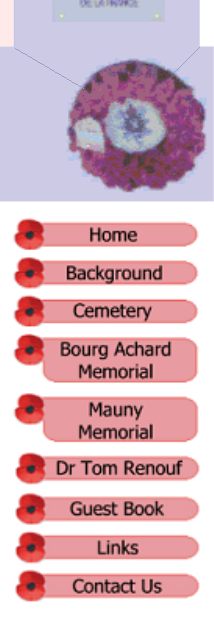

English |

Français |

"Nemo me
impune lacessit"
("No one provokes me
with impunity")
|
|
|
|
|
George Aconley Hildred
Son of Lawrence Aconley Hildred and Alice Hildred, York
26th May 1926 - 28th Aug 1944
|
|
George, the 2nd born Son of
Lawrence Aconley (York) & Alice nee Daniels (Old Malton), spent the first 6 years of his life living in Kirk
Hammerton, where his
Father was the village postman.
In 1933 the family moved to 90 Rose Street, York then later to 19
Wigginton Terrace, York and George attended Park Grove School.
Always wanting to wear
a uniform he became a Cub then a Scout before joining the Sea Cadets at their Headquarters on Lord Mayor's Walk in the
City, he then became a member of the St John's Ambulance Brigade.
|
|

George in his Sea
Cadet
uniform 31st
Jan 1942
|
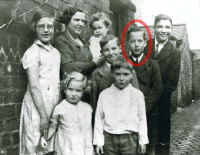
George with his Brothers, Sisters
and Mother behind 90 Rose Street York. |

Lawrence & Alice on
their wedding day 1922
|
|
During the first
bombing raid on York, 11th August 1940, George's Brothers and Sisters sought
refuge under the stairs whilst his Mother and Father stayed in the
living room.
In the confusion George had managed to slip away and ran
to the City centre to offer help to the Fire Service, after this
experience he volunteered as a messenger with the Auxilliary Fire Service
(A.F.S.), their station was adjoining the York Rugby League ground on
Wigginton Road.
On 10th July 1940
George became a fitters apprentice at London & North Eastern
Railway in York.
|
|
Early on the morning of 29th Apr 1942 the family were shaken from their beds by a bomb that had demolished a shop on the corner of Rose Street and
Wigginton Terrace, 4 doors from his home. After the air raid warning had silenced George reported, with his bicycle, for duty. Later that day he arrived
home with his bike punctured and by a circuitous route as the area of his home had been evacuated and cordoned off as the 1,000lb bomb was unexploded
(U.X.B.). The family was spread around relatives, George going to his Aunt Ethel's in
Thorganby, his parents went to a rest centre in the Dining
Block on Haxby Road supplied by Rowntree's (R & Co Ltd). As telephones
were less common in those days it was up to the Police to return everyone to their homes when
the bomb had been recovered. |

The shop on the corner of
Rose Street and
Wigginton Terrace
|
|


|
His elder brother John (Jack) had already enlisted in the The Black
Watch and George was eager to follow him so a day after his 17th Birthday he
went to No 68 Recruiting Centre in York and after giving a false
date of Birth and occupation was enlisted on 27th May 1943.
|
|
George was then posted to No 58
Primary Training Wing at Queen's Barracks, Perth, Scotland on 28th May 1943 and
then on to No 8 Infantry Training Centre at the same Barracks. After training he
was transferred to The Black Watch on 12th Aug then on to the 4th Battalion
Black Watch on 6th Nov. At some time between 6th Nov and 28th Aug 1944 he was
transferred to the 5th Battalion, it is suspected that this was on deployment to
France on 20th August 1944 but cannot be confirmed.
He landed on Juno beach on the 20th August 1944, prior to this the Battalion
had suffered heavy losses in previous days at
Breville. They pushed on to Ranville to the East of the river Orne where
they engaged the Germans for several hours. On the 26th June they took part
in a major assault on Caen before taking over from the 5th Seaforths in St
Honorine la Chardronette 1 mile from Colombelles. On the 7th July they moved
to the North East corner of a factory in Colombelles to secure the
crossroads, the factory's two chimneys were to be blown as they were being
used by the Germans to view the Allies progress. By the 11th July the
factory was still in German hands and the Battalion had lost some 25% during
the battle, a decision was then made to withdraw. On the 12th they took over
from the Devon Regiment in Ranville and subsequently arrived at the rest
area at St Aubin d'Arquenay. After a rest they moved to Anguerny to prepare
for the next phase, the 51st had gained much respect after Colombelles and
joined the 2nd Canadian Corps. On the 6th August they were moved, by RASC
troop carriers, through the Caen Column and marched from there on to
Bourguebus. After several hours La Hogue was taken on the 9th August
following heavy bombing by the RAF, on the 10th they took over fighting for
St Sylvain from the Polish.
 |
The 14th August saw the Battalion in a daylight battle in Le Bu sur Rouvres
where they took 200 prisoners, they then cleaned up and moved on to Percy en
Auge where they came across booby traps which accounted for one member
of the Battalion. On the 17th they planned to cross the river Dives to the
East of Ecajul but the bridge at Ouville had been blown and the nearest was
3 miles up river at St Pierre sur Dives so they cleared the village of Le
Buhot and constructed a pontoon bridge across the river. Despite heavy
rainfall they marched on to meet their transport which was to take them
North East towards Lisieux. George arrived in France on 20th Aug 1944, the 22nd August saw the enemy withdrawing
Eastwards and the Battalion pressed forward. On the 23rd they took over from
5/7th Gordons who had been fighting through Lisieux, after another night of
heavy rainfall the roads were cleared and they rested for 48 hours 2 miles
East of the town.
On the 28th August they set off in transport to Bourg Achard, Barneville sur
Saine was cleared of the enemy and they planned to capture Mauny. They were
shelled in an orchard near to the crossroads and moved on to the Chateau.
Still under heavy fire they stormed the building finding the cellars full of
refugees and the Germans upstairs. 'B' Company led by Major Donald
Mirrielees came through 'C' Company after a fierce fight in the woods, it's
during that fight in the woods that George lost his life to a fatal bullet
wound See
Update. The action ended on 2nd September when the
Battalion crossed the river Seine. 6 men died, 1 Major, 4 N.C.O's and 1 Private 14433352 George
Hildred aged 18.
Donald Mirrielees,
James O'Keefe, Harry Billington and George Hildred were buried at the nearby
Casualty Clearing Centre, their bodies were later exhumed and finally
laid to rest at St Desir cemetery. |
The good people of Bourg Achard and the surrounding area erected a memorial to George and his comrades. The
memorial stands at the Haut Croth crossroads where the Casualty
Clearing Centre was erected prior to the action.
His name is also on The Scottish
National War Memorial Roll of Honour in Edinburgh
Castle

The route the 5th
would have taken.
| Although a request was
made for his medals to be forwarded on to the family these were sadly
never received.
George would have been entitled to the
following.............. |
 |
1939-45 Star. The 1939-1945 Star is the first in a series of
eight campaign stars instituted in 1945 to recognise service in the
Second World War. It was awarded for six months service in
specified operational areas. Those whose service was shortened
by death, injury or capture or who were awarded a decoration or
mention in despatches also qualified for the medal. This bronze
six-pointed star has a circular centre with the GRI/VI monogram,
surmounted by the Royal crown, and inscribed 'The 1939-1945 Star'. The
star has a height of 44mm and maximum width of 38mm. The
1939-1945 Star was issued unengraved to New Zealand service persons,
as were other Second World War campaign medals awarded for service for
New Zealand. The same no-engraving policy was applied by other British
Commonwealth countries, except for Australia and South Africa.
The ribbon has equal stripes of dark blue, red and light blue,
symbolising the Navy, Army and Air Force, respectively. One
clasp, ‘Battle of Britain’ was awarded for aircrew who saw service
during the Battle of Britain in 1940.
|
 |
France and Germany Star. The France and Germany Star was
awarded for service in France, Belgium, the Netherlands, Germany and
adjacent sea areas between 6 June 1944 and 8 May 1945. This
bronze six-pointed star has a circular centre with the GRI/VI
monogram, surmounted by the Royal crown, and inscribed 'The France and
Germany Star'. The star has a height of 44mm and maximum width of
38mm. Personnel qualifying for both the France and Germany Star
and the Atlantic Star were awarded the first star they qualified for,
and a clasp in respect of the second star. The ribbon has five
equal stripes of blue, white, red, white and blue. These colours are
the national colours of the United Kingdom, France and the
Netherlands. One clasp, ‘Atlantic’ was awarded with this
medal.
|
 |
War Medal 1939-45 (obverse and
reverse). This medal was awarded to all fulltime members of the
Armed Forces for 28 days service between September 1939 and September
1945 irrespective of where they were serving.
|
 |
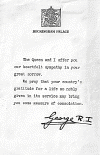
The letter of condolence from
Buckingham Palace
received by many families who suffered a loss.
|
Update: Aug/2024
|
During a visit in August 2024 (To mark the 80th anniversary of
the liberation of Bourg Achard) we took our 12 year old
Grandson, Aiden. He laid a poppy cross at the fallen tree stump
outside Mauny and was honoured to assist the Mayoress in
unveiling a new memorial to outside Bourg Achard town hall.
We also travelled to the British
Normandy Memorial at Ver-sur-Mer, unveiled on 6th June 2021. The
memorial records the names of 22,442 service men and women who
lost their lives during the Normandy campaign, George's
inscription is on column 330.
|
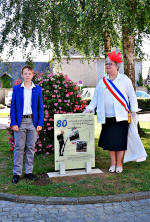 |
|
|
|
Update: 2017
|
New
information has now come to light about the events surrounding
George's death...
We were contacted by Gus Brydon
(Son
of Private George Brydon) although wounded his Father survived and
in 2016 was awarded the 'Legion of Honour' in Edinburgh Castle
presented by the French
Ambassador, George wanted to mention that
the medal wasn't just for him, but to all the soldiers who didn't
return home. Private Brydon landed
in France on the 29th of July to join
'B' Company.
It seems that George Hildred was fatally
wounded on the 28th August at the same road block ambush where Tom
Renouf was also wounded and not as previously thought, in the
grounds of Chateau Mauny.
The Company had
approached a temporary German** road block made
from felled trees, George was
climbing over one of the felled trees when he received his fatal
bullet wound! Gus asked his Father if he is sure about the rank of
the soldier shot a metre away from him and he confirmed that he was
the same rank as himself, a Private (The only Private to die on
the 28th was George Hildred).
On the 29th 'B' Company
advanced once again to the road block where his body still lay
and proceeded in the direction of the Chateau. at
the crossroads at the South West corner of the grounds Major
Mirrielees and the other Officers were planning encircling the
Chateau when all hell let loose and mortars started raining down on
the group from the Chateau grounds near the house. Private Brydon
was standing quite close to the Major and turned to run and dive
into a ditch, but was hit and blown clear into bushes, where he lay
still until the bombardment, which lasted about 10 minutes with
heavy machine gun fire coming from the tree line perimeter of
the Chateau ended. Shortly after, the British tanks started up and
headed across the fields to attack the Chateau defences. It was then
that Private Brydon was reached by a Field Medic and carried away to
safety, he couldn't walk to the 'medical caravan' that was
set up on the outskirts of the village and was eventually carried to
Bayeux on a stretcher across a Jeep.
|
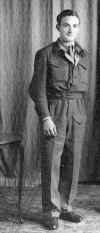
14709016 Private George Brydon
1944
|

Receiving the
'Legion of Honour'
medal 2016
|
|
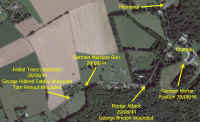
Plan of the area surrounding
Chateau Mauny
|
|
Update:
March 2018
Sadly,
George Brydon
passed away on 05/03/18.
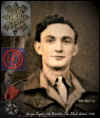
|
|
|
|
Update: 25th March 2017
(More on
the 2017 visit here , here
& here)
| This
is the area where Tom Renouf said the road was
blocked by felled trees, we found the stump of a very old
tree and although we will never be 100% certain have
placed a cross here to mark the spot were we believe
George died.
|
 |
 |
|
|
360 Degree Images
(For 360 viewers i.e. Google
Cardboard)
 |
|

The road where the felled trees
are thought to have been
|

The crossroads by the Chateau,
the scene of mortar attack on the 29th
|
|
Undated
article written by Lieutenant Dr Tom Renouf, who served with the 5th
Battalion The Black Watch of the 51st Highland Division. Tom Renouf was
a newly enlisted 19-year-old soldier when he landed on Sword
beach on D-Day plus two.
These are his memories of 28th August 1944 during the same skirmish as
George:
|
It seems that as you grow older, those memories that do not fade start to get stronger. For me there is one that, over the past
forty odd years keeps creeping back from the dark shadows of my mind bringing with it a clear and vivid image. Today it seems to come into my thoughts more often than it did in the past, and I feel there is a sort of pressure on me to put the memory into words.
Each time I hear the tune Je t’endrais and the memories that are linked to it, I am taken back over the years to the events of a day in August 1944.
After the battles of the Normandy campaign, many of the fighting units were so badly depleted that an amount of
re-organisation was necessary. As a result of this I was transferred from the Tyneside Scottish to the Fifth Battalion of the Black Watch.
|
|
|

Dr Tom
Renouf
Picture: Neil Hanna
|
|
|
For the first time I found myself
in the same section of 7 platoon as my buddy, Alex Corris, from the Isle of
Man. We had joined the army on the same day and although our
paths had diverged on occasions, we were and still remain very close friends. I
remember thinking. that I did not, want to be this close to Alex possibly because of a superstition concerning the
ill fate of close friends.
The battalion had just liberated a part of Lisieux, the Germans we were told, were “on the run” and we were having two days rest.
I remember the sheer exhaustion and battle weariness that showed on the faces of my new comrades. The battalion was
battle seasoned, it had fought its way from El Alamein and despite heavy casualties, there were still a few of its number that wore the
much respected Africa Star.
My new section leader was Corporal Chapman, both he and
Ginger
(Sargeant Thomas Kirkcaldy) wore the
much respected medal, but the rest of us were 19 year old and veterans only of the Normandy
battles. Chapman was a fine soldier and won our confidence and
respect immediately. He was an efficient but a kindly person,
neat and smart in his turn out but very understanding. He looked
after us new veterans like Father figure, but at the same time controlled us as a fighting unit.
Ginger, as he was affectionately known was friendly and well liked by everyone.
He had a rare quality that was seldom to be found or shown by soldiers. When he spoke to you, it was like speaking to an older brother. He was most concerned about your
well being and intently interested in everything about you. As a result of this, he seemed to enjoy a close
personal relationship with everyone, even the hardest of men and I am sure many confided in
him. He would be sure to ask if things were alright, or how the family were getting on, or if you were getting letters, etc. From the start, he welcomed us with great kindness, gave us a lot of help in settling in and established this close relationship with us all.
After two days, our rest period was over and we moved out, carried by lorries, back to the combat area. The battalion’s task was to
mop up a pocket of resistance left behind by the retreating enemy to
delay our advance. The pocket was on the nearside of the Seine
in country that was hilly and lightly wooded and very different
from the bocage of Normandy.
As we advanced towards the battalions objective, there was little evidence of enemy
presence. After a halt, Corporal Chapman told us that the leading company had taken all the objectives unopposed and that there was no sign of enemy troops. He also told us that the second objective had been given and that another company was leading the attack. This objective was taken and still no signs of resistance.
After various ‘O’ group meetings, a third objective was announced and this time it was our company that was leading. We
also learned that our platoon was leading the company, and our section, under
Corporal Chapman, leading the whole attack.
Every infantryman knows that the leading section was exposed to
all risks, that the chances of being a casualty were very high and that your fate was in the
hands of God. On this occasion, however, our chances of survival seemed
considerably improved since there was no sign of the
enemy.
We set off from a wooded area into undulating hill land. We moved forward,
well spread out, looking all around for any threatening signs of hostility. There was no shelling, there were no
sounds of the dreaded mortars and no sign of the enemy. It was a
pleasant sunny day and the farther we moved the less we felt threatened. We
traveled past a roadblock of felled trees and through a minefield of six or eight
anti-tank mines laid in the road and easily identified. About 100 yards ahead of
this there was another roadblock of felled trees and a wood just
beyond. Perhaps we should have recognised the possible danger, but everything was so tranquil that we had become a little
complacent. We approached the roadblock and just as we
were climbing over the trees a burst of machine-gun fire opened
up on us from the wood ten yards ahead. Instinctively, we moved like lightning. I found myself lying behind a
sawn off tree stump. There was more fire, the bullets kicked up the earth first to the left then to
the right of my tree stump, and I wriggled to keep out of the
line of fire. When it stopped, we had time to think. It sounded like a
Schmeisser hand machine gun almost certainly on the left. I went into my pouches for a grenade as I am sure the others did, but I found first a tin of sardines, then a tin of bully beef and
eventually a grenade. Rather foolishly, we had given higher priority
to the buckshee rations we had, for the first received than to our
essential weapons. By this time, I had the feeling that the immediate danger was passed. I looked for
Alex, he was crouched in a fold in the ground barely enough to afford protection. I shouted to him and he said he was alright. I then felt something hot running down my back and said to Alex, “I think I have been hit.” He very bravely crawled up to me, removed my pack and quietly said, “Tom, get back as quick as you can.” I can still remember concern and anxiety in his voice and this puzzled me because I felt quite well.
I made my way back to the first aid post where I was examined by the Medical Officer and told to get into the Field Ambulance. I was shortly joined by two more walking wounded and after some time two stretcher cases
were brought in. I was happy to be on my way back to hospital and out of the
fighting , but I was badly shaken when I discovered that the two
badly wounded cases were Corporal Chapman and Ginger. I
did not know that they had been seriously wounded at the same time as I was.
The ambulance set off for Bayeux about 100 kilometres away, a journey that was to take us well over 12 hours on account of the
shell-pocked roads and the heavy traffic. We passed through four aid posts where we got essential medical treatment. Two of these were Canadian where we were given the best of attention and much kindness, and two were British where we were treated quite indifferently.
It was the middle of the night when we arrived at the last of these aid posts. I knew that both Corporal Chapman and Ginger were seriously wounded and very
weak. Neither of them had regained consciousness and
there was little that we could do for them. When they were stretchered out
of the ambulance and into the light of the reception
tent, we feared the worst. The M.O. examined them and much to my grief pronounced both of them
dead.
This sad loss was made all the more tragic for me for two reasons. As I watched all of this
going on, my thoughts were concerned only with the fate of my two
comrades I was
only vaguely aware of music coming from a nearby radio but then it suddenly struck me, the tune that was being played was Je
t’endrais and then I remembered that this was Ginger’s
favourite tune, it was being played as he passed away. I was also struck by the injustice and the strange quirks of fate. The two that had been killed in this attack were the two old soldiers, who had
traveled far under the banner of good fortune and who, within
sight of the final goal, had been taken by fate. I felt, that
they, before any others in the section, deserved to see final
victory.
I went on to hospital in Bayeux and after a few weeks was back with 7 platoon
I was greeted by my old pal Alex who had volunteered to become
a stretcher bearer, one of the most dangerous jobs. He was glad to see me, it had been a bad day for casualties and he said he felt lucky to
be alive.
At that time there were many bad days and hard battles ahead of us.
We were both fortunate enough to survive the war and at the end of it we found ourselves
billetted in a beautiful little German village called Steyerberg. There were very few of us who had survived
from the Normandy beaches but during these days we talked a great deal about the past, recalling various happenings and remembering the many who had not been as lucky as we and we often spoke of Corporal Chapman and Ginger, our two Africa Star comrades. We knew only too well the chances of survival for an infantryman. The chances of surviving from El Alamein to Berlin was practically
nil, out of all the members of 7 platoon who had started at the beginning, only one was left at the end. He was our platoon sergeant and great friend, Wick, but en route he had been wounded twice.
The Highlander
On the 10th June
1944 the Highland Division made it's first attack from The Bois
De Monts towards Breville. In this and the action at Chateau St
Come 110 men were killed in two days. Vastly outnumbered and
against ferocious counter attacks the Highlanders helped to
secure the Orne Bridgehead only by steadfast dedication, courage
and sacrifice.
An impressive
monument to this action has been erected just outside Breville, click
here for it's location.
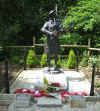
St Valery En
Caux Monument
Location
The Black Watch
Monument was erected in 1950 and is made from a block of granite
quarried near Balmoral. It is dedicated to all ranks of the 51st
(Highland) Division who lost their lives between 1939/45.
Bruar Monument
Location
|
The
eight-foot high piper which stands on a 10 foot granite
block was sculpted by Alan Herriot and is a duplicate of
the Normandy figure built for the 60th anniversary of the
D-Day landings.
Dr Tom
Renouf said the monument is in honour of the five Highland
regiments - the Gordons, the Camerons, the Argylls, the
Seaforths and The Black Watch.
|
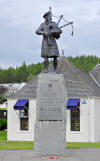 |
 |
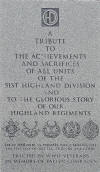 |
|
|
|
|
|
|
|

